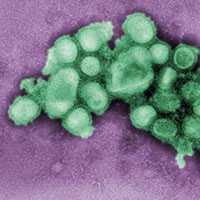Tackling the H1N1 Flu Pandemic Through the Rapid Detection of the Novel H1N1 Virus
 H1N1 influenza emerged in the US in 2009. Within a year, it caused a worldwide pandemic that resulted in an estimated 60.8 million cases, 274,304 hospitalizations, and 12,469 deaths in the US alone. Global estimates of the 2009 H1N1 pandemic indicated that 151,700 – 575,400 people died, with the majority of deaths occurring in Africa and Southeast Asia. Approximately 80% of the 2009 H1N1 deaths occurred in individuals below the age of 65. H1N1 flu now circulates seasonally as a regular flu virus. A rapid, highly sensitive method for diagnosing the H1N1 flu was needed to reduce the spread of the virus and initiate antiviral treatment of the illness.
H1N1 influenza emerged in the US in 2009. Within a year, it caused a worldwide pandemic that resulted in an estimated 60.8 million cases, 274,304 hospitalizations, and 12,469 deaths in the US alone. Global estimates of the 2009 H1N1 pandemic indicated that 151,700 – 575,400 people died, with the majority of deaths occurring in Africa and Southeast Asia. Approximately 80% of the 2009 H1N1 deaths occurred in individuals below the age of 65. H1N1 flu now circulates seasonally as a regular flu virus. A rapid, highly sensitive method for diagnosing the H1N1 flu was needed to reduce the spread of the virus and initiate antiviral treatment of the illness.
CDC scientists Stephen Lindstrom, Bo Shu, Shannon Emery, and LaShondra Berman developed a real time RT-PCR assay for the detection of the novel H1N1 virus. The assay provides oligonucleotides that are designed to specifically detect H1N1 influenza signatures, and also an Influenza A subtyping panel of signatures. The technology was licensed to Biosearch Technologies, and was commercialized as the 2009 H1N1 (Novel Influenza A) ValuPanel™ and PDM 2009 H1N1 (Novel Influenza A) ValuPanel™. The panels are commercially available in countries across Africa, Asia, Europe, the Middle East, and North and South America. The technology was also licensed to Life Technologies, and is commercially available as the Pandemic H1N1/09 Assay Set v 2.0. The product is available in Malaysia, India, Ecuador, Czech Republic, Brazil, Vietnam, Thailand, Romania, Israel, Morocco, Lebanon, Jordan, Italy, Portugal, Chile, and the Philippines.
- Page last reviewed: June 29, 2017
- Page last updated: July 8, 2016
- Content source:
- Office of the Associate Director for Science


 ShareCompartir
ShareCompartir